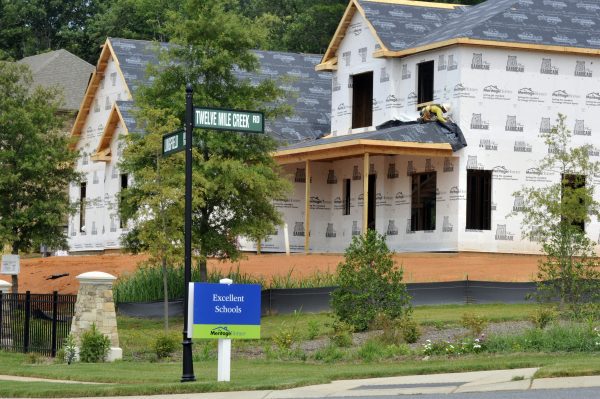The bounce is back for Charlotte-area suburban growth

Since the recession ended, there has been a lot of discussion among demographers, pundits and others about Americans moving back to cities. For the first time in years, migration patterns were showing cities growing faster than suburbs. Research was starting to suggest that not all Americans are dreaming of a big house, lawn and an SUV in the suburbs, but some dream of an apartment or condo in a walkable neighborhood in the city. After hearing numerous accounts of individuals disenchanted with lackluster suburbs, some hailed this nascent trend as the dawn of what they hoped would be a new era, an urban renaissance.
But just when many had left the suburbs for dead, the latest population estimates from the Census Bureau show signs of resurrection. After three years of abnormally low suburban growth and slightly elevated urban growth, the suburbs are once again growing faster than cities.
The rollercoaster of suburban growth in the Charlotte region
Rapid suburban growth was one of the hallmarks of the 2000s, but it slowed considerably when the housing bubble burst and the recession began in 2007. This dramatic change is clearly illustrated in the graph below, with population growth in Union, Cabarrus and York counties – all adjacent to Mecklenburg – peaking around 2007, followed by a steep decline in 2008 and 2009, and bottoming out in 2010.
The rise and fall was especially pronounced in Union County, which was the fastest growing county in the region and the entire country for a few years, growing more than 4 percent each year since 2000. Its growth peaked in 2006 at 7.3 percent, fell slightly in 2007, then nose-dived to 1.4 percent in 2010. (Article continues below chart.)
After the economic downturn eased in 2010, a new pattern emerged: the resurgence of urban growth. For several years, the urban cores of cities were growing faster than the suburbs and exurbs. In the first year after the 2010 Census, Mecklenburg County grew quite a bit faster than all its surrounding counties, including Union. For the next two years, Mecklenburg continued to outpace its suburban neighbors, even as the pace of its growth slowed.
The most recent data, however, show that from 2013 to 2014 this trend in the Charlotte region reversed, with growth picking up in several suburban counties. Although the uptick wasn’t dramatic or even close to pre-recession growth levels, it was enough to overtake Mecklenburg.
Looking at the full, four-year period, however, Mecklenburg still leads the region, growing by 10 percent, while the suburban hotspots saw growth rates of between 8 and 9 percent.
One new variation on the region’s continued suburban growth in 2014 was the rapid rise of Lancaster County, S.C. Lancaster was not only the fastest growing county in the region in 2014 but also the fastest growing county in the Carolinas.
After seeing modest annual growth through 2013, Lancaster’s growth rate spiked in 2014, leapfrogging that of Mecklenburg and the other high-growth suburban counties of Union, Cabarrus, and York, S.C. This sudden burst of population growth can clearly be traced to the dramatic uptick in building permits issued in Lancaster County in 2013, resulting in a flurry of new homes popping up in Indian Land and along the Mecklenburg County border.
Rural decline continues
While the region’s suburban counties have seen a resurgence of growth, many of the region’s rural counties continue to struggle with population loss. Anson County, one of the most rural counties in the region, has seen the greatest decline, losing more than 4 percent of its population since 2010. Some of this loss has come through natural decrease (more deaths than births), but the majority is due to out-migration to other counties.
Rural areas across the Carolinas are experiencing a similar phenomenon, as the map below shows. While the metro areas continued to grow, about half of the counties in the Carolinas lost population between 2013 and 2014. Many of these counties have been steadily losing population since 2010. A handful have lost 5 percent or more of their population since 2010 – places like Northhampton, Tyrrell, and Bertie counties in northeastern North Carolina, and Bamberg and Allendale counties in South Carolina near the Georgia border.
Like Anson, these counties are losing population to other counties. Although many are still experiencing natural increase, that’s not likely to continue for long, given the aging population in many of these counties.
Growth is concentrated in metro areas
The other trend that appears across the two states is that the strongest growth since 2013 has occurred in the metropolitan regions, a trend observed since 2010. After slowing during the recession, the growth of metro areas (which include both the urban core and surrounding suburbs) has picked up pace once again.
The Myrtle Beach metro area was the second fastest growing in the country from 2013 to 2014 (3.2 percent). Hilton Head was 13th and Raleigh 15th. The Charlotte metropolitan area was 39th in growth rate but gained enough people to surpass Pittsburgh and become the nation’s 22nd largest metro area.
Much of the growth in Carolina’s metros has come from domestic migration. Since 2013, the Charlotte area gained more than 24,000 domestic migrants, the ninth largest gain of large metros nationwide. However, that rate is still well below the influx Charlotte experienced just before the recession (2005-06), when the metro area gained nearly 54,000 in new residents from elsewhere in the U.S. in a single year.
